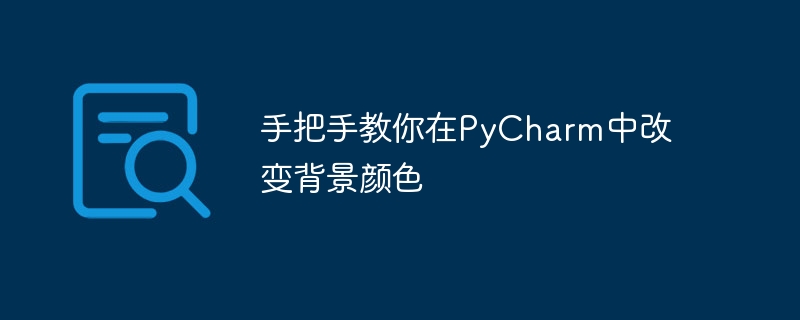

Teach you step by step how to change the background color in PyCharm, you need specific code examples
1. The importance of background color
For software developers Said that a comfortable development environment is very important. As a powerful Python development tool, PyCharm provides many personalized configuration options during the development process, one of which is the ability to change the background color of the code editor.
By default, the background color of PyCharm's editor is white. For developers who edit code for a long time, the white background may have a dazzling effect, affecting the efficiency and comfort of development. Therefore, it is very necessary to change the background color of PyCharm.
2. Steps to change the background color in PyCharm
Below, I will use a practical example to teach you step by step how to change the background color in PyCharm.
Step 1: Open PyCharm
First, open your PyCharm development environment.
Step 2: Enter the configuration interface
Click "File" in the menu bar, then select "Settings" to enter the PyCharm configuration interface.
Step 3: Select Appearance and Behavior
In the pop-up "Settings" window, select "Appearance & Behavior" on the left, and then select "Appearance".
Step 4: Modify the background color of the editor
In the "Appearance" page, you can see the background color option of the editor. By default, the background color is "Default", which is white. Click the drop-down menu on the right to see some predefined choices, such as "Darcula" and so on.
By selecting "Darcula", the background color will be changed to dark gray, suitable for reading and editing code for a long time. You can also choose other colors or a custom background color.
Step 5: Apply changes
After completing the selection of the background color, click the "OK" button at the bottom of the page to apply the changes to PyCharm.
3. Code Example
Below, I will give a specific code example to demonstrate how to change the background color in PyCharm:
import javafx.scene.Scene;
import javafx.scene.control.*;
import javafx.scene.layout.*;
import javafx.application.Application;
import javafx.stage.Stage;
import javafx.scene.paint.Color;
public class HelloWorld extends Application {
public void start(Stage primaryStage) {
BorderPane root = new BorderPane();
Scene scene = new Scene(root, 300, 200);
scene.setFill(Color.DARKGRAY); // 设置背景色为暗灰色
primaryStage.setTitle("Hello World");
primaryStage.setScene(scene);
primaryStage.show();
}
public static void main(String[] args) {
launch(args);
}
}In the above code, I created a simple window using JavaFX and set the background color to dark gray.
4. Summary
Through the above steps and code examples, I believe you have learned how to change the background color in PyCharm. In the actual development process, you can choose a background color that suits you according to your preferences and needs.
Changing the background color not only improves the readability of your code, but also allows you to enjoy a better visual experience during long-term development. I hope this article was helpful to you, and I wish you happy programming in PyCharm!
The above is the detailed content of Using PyCharm, teach you step by step how to customize the background color. For more information, please follow other related articles on the PHP Chinese website!




